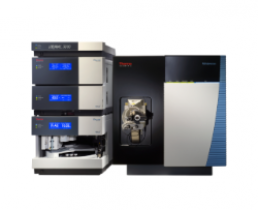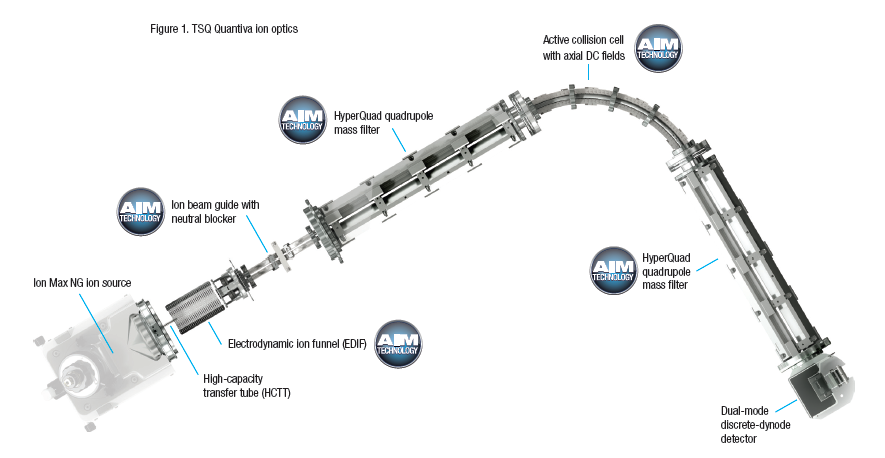



Hardware Features
Thermo Scientific™ Ion Max NG™ API Source
• Automatic connection of all gases and voltages on installation simplifies operation and improves reliability
• Automatic source recognition simplifies use and data logging
• Sweep gas reduces chemical noise
• Enhanced exhaust port efficiently removes solvent vapor, improving uptime and reducing chemical noise
• Flexible X, Y, and Z positioning for all ionization probes maximizes performance
• Optimal 60 degree spray angle
• Interchangeable HESI and APCI ionization probes
• Dual-mode HESI and APCI capability
High-Capacity Transfer Tube
The high-capacity transfer tube (HCTT) allows more ions into the vacuum system for improved sensitivity while still providing great desolvation.
Active Ion Management Ion Optics
AIM technology maximizes ion transmission, eliminates major sources of noise, and precisely isolates analytes to achieve extreme quantitative performance.
Electrodynamic Ion Funnel
The electrodynamic ion funnel (EDIF) efficiently captures ions as they leave the transfer tube. Its broad transmission curve reduces ion losses, increasing sensitivity.
The EDIF also reduces in-source fragmentation.
Ion Beam Guide
The ion beam guide, with its neutral blocker, stops neutrals and high-velocity clusters, keeping the ion optics cleaner, reducing noise, and increasing sensitivity.
HyperQuad Quadrupole Mass Filter (Q1 and Q3)
Thermo Scientific™ HyperQuad™ quadrupole mass filters with 6 mm field radius and asymmetric RF drive increase ion transmission and sensitivity. Resolution up to 0.2 FWHM enables better selected-reaction monitoring.
Active Collision Cell (Q2)
The high-pressure argon-filled collision cell produces efficient fragmentation for high sensitivity. An axial DC field speeds ion transits, yielding up to 500 SRMs/s with zero cross talk.
Detector
• Dual-mode discrete-dynode detector increases sensitivity by operating in pulse-counting mode when ion flux is low and analog mode when ion flux is high
• Six orders of dynamic range provide high-confidence quantitation
Vacuum System
• Four-stage differentially pumped vacuum manifold
• Advanced triple-inlet turbomolecular pump integrated with the vacuum manifold
• Dual rotary vacuum pump configuration
Integrated Divert Valve and Syringe Pump
Fully automated data system control of the divert valve enables switching the solvent front, gradient end point, or any portion of the HPLC run to waste.
Optional Ion Sources
• Thermo Scientific™ EASY-Max NG™ ion source provides high performance with minimal adjustments
• Thermo Scientific™ EASY-Spray NG™ ion source is designed for maximum nanoelectrospray performance with no need for adjustments
• Thermo Scientific™ Nanospray Flex NG™ ion source is designed for ultimate nanoelectrospray performance with complete flexibility of column selection

Software Features
Data System
• High-performance PC with Intel® microprocessor
• High-resolution LCD color monitor
• Microsoft® Windows® 7 operating system (64 bit)
• Microsoft Office 2010 software Standard MS Software
• Thermo Scientific™ Xcalibur™ processing and instrument control software
• Tune editor for system calibration, diagnostics, and manual data acquisition
• Method editor with comprehensive application-specific template library and drag-and-drop user interface to facilitate method development
• Automated optimization of all instrument parameters, including gas pressures and collision energy, within an experiment
• Direct control of multiple vendors’ LC systems and autosampler configurations through Xcalibur software
• Foundation of shared, state-of-the-art software makes it easier to transfer methods between next-generation instruments
Scan Functions
• Highly sensitive full-scan MS in Q1 or Q3
• Selected-ion monitoring (SIM) in Q1 or Q3
• Selected-reaction monitoring (SRM) with up to 30,000 SRMs definable and up to 500 SRMs/s
• High-resolution (0.2 Da) selected-reaction monitoring
• Product ion scanning
• Precursor ion scanning
• Neutral-loss scanning
• Reverse energy ramp MS/MS spectra (RER) gives information-rich MS/MS spectra for solid compound identification
• Polarity switching capabilities
Optional Application-Specific Software
• Thermo Scientific™ LCQUAN™ quantitation software supports 21 CFR Part 11 compliance
• Thermo Scientific™ TraceFinder™ software simplifies method development and routine analysis in food safety, environmental, clinical research, and forensic toxicology laboratories
• Thermo Scientific™ Pinpoint™ software automates peptide quantitation applications
• Thermo Scientific™ Mass Frontier™ spectral interpretation and classification software for the identification of unknowns
Performance Specifications
Sensitivity
Positive Electrospray (HESI) at Resolution 0.2 Da FWHM
A 2 μL injection of a 500 fg/μL reserpine solution on a Thermo Scientific™ Hypersil GOLD™ aQ 20 x 2.1 mm 1.9 μm particle packed column at a flow rate of 300 μL/min 30:70:0.02 water/methanol/formic acid will produce a minimum signal-to-noise ratio of 100,000:1 for the transition of the protonated molecule at m/z 609.3 to the fragment ion at m/z 195.1 when operated in selected-reaction monitoring (SRM) mode with Q1 and Q3 resolution set to 0.2 and 0.7 Da FWHM respectively.
Mass Range
m/z 10-1850
Resolution
Q1 and Q3 adjustable to 0.2 Da peak width (FWHM) across the entire mass range
Scan Rate
15,000 amu/second at a resolution of 2 FWHM 500 SRMs/second (for any resolution from 0.2 through 2.0 FWHM)
Mass Stability
Mass assignment will be within ±0.05 Da over a 24 hour period. The laboratory room temperature must be maintained between 18–27 °C (65–81 °F). The room temperature may not change by more than 5 °C (9 °F) during this period.
Installation Requirements
Power
• Three 230 Vac ±10%, 50/60 Hz at 16 A minimum
• Four 120 Vac +6–10%, 50/60 Hz at 20 A or four 230 Vac ±10%, 50/60 Hz at 13 A
• Earth ground hardwired to main panel
• Free from voltage variations above or below the recommended operating range
Gas
• Collision gas: 99.995% pure Argon
• Collision gas supply pressure: 135 ± 70 kPa (20 ± 10 psig)
• Sheath/aux/sweep gas: 99% pure Nitrogen
• Sheath/aux/sweep gas supply pressure: 690 ± 140 kPa (100 ± 20 psig)
• Maximum sheath gas consumption: ≈20 L/min
Environment
• Functional temperature range: 15–27 °C (59–81 °F)
• Optimal temperature range: 18–21 °C 65–70 °F)
• Heat output: 1550 W (5400 Btu/h)
• Total system heat output: 4420 W (15,380 Btu/h)
• Particulate matter: <3,500,000 particles per cubic meter of air (<100,000 particles of >5 μm diameter per cubic foot of air)
• Relative humidity: 20% to 80%, without condensation
• Floors must be free of vibration
Dimensions
Size
• TSQ Quantiva MS1: 680 × 760 × 840 mm (h, w, d – 27 × 30 × 33 in)
• Oerlikon® SV 65 forepump: 270 × 320 × 489 mm (h, w, d – 10 × 13 × 19 in)
Weight
• TSQ Quantiva MS: 125 kg (275 lb)
• Oerlikon® SV 65 forepump: 52 kg (115 lb)
1. Includes the divert/inject valve